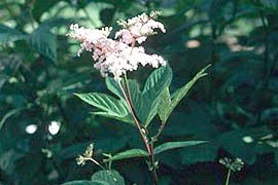Queen of the meadow
(Filipendula ulmaria)
An upright, clump-forming perennial of moist habitats. Flowers are showy, erect clusters of fragrant, white blooms. Typically grows three to four feet in height, sometimes reaching up to six feet.
Other names for this plant include:
- Common names: meadowsweet, mead wort, steeplebush, bridewort
- Scientific names: Spiraea ulmaria, Ulmaria pentapetala
Classification in Wisconsin: Restricted
- Ecological Threat
-
- Invades wetlands, bogs, fens, marshes, floodplain forests, moist meadows, freshwater estuaries, wet rock ledges and roadside ditches.
- Crowds out native vegetation in favored habitats.
- Reproduces vegetatively as well as by seed. Readily self-seeds.
- Prefers fluctuating water levels; seeds can float for several weeks.
- Identification
-
Leaves & stems: Pinnately compound dark-green leaves with five pairs of coarsely toothed and deeply veined leaflets. Leaves are hairy and whitish on the undersides. Stems are woody at the base. Tiny leaflets occur on stems between the leaves.
Flowers: Showy and fragrant. Branching panicles or cymes (erect clusters) of small, white-cream-colored flowers. Individual flowers have five petals and numerous stamens, giving the flowers a "fuzzy" appearance.
Fruits & seeds: Spherical, irregular and twisting. Resembles cultivated garden Nasturtium seeds.
Roots: Produces rhizomes (stem-roots), which aid in their spread.
Similar species: Filipendula rubra is a common ornamental plant native to the southeastern United States. Leaves are palmately compound and flowers are pink in color.
- Distribution
-
See the reported locations of the queen of the meadow in Wisconsin.
Do you know of other populations? Please send us a report.
- Control
- Mechanical
- Dig up the entire plant and remove the whole root system, as plants spread by rhizomes.
- Cut or mow flowering tops before maturation to prevent seed set. Continual cutting and mowing are needed as plants re-sprout.
- Use an aquatically-approval herbicide. Monitor for re-sprouts.
- Resources
- Sources for content:
- Wisconsin State Herbarium (WISFLORA), Department of Botany, University of Wisconsin.
- K. Falinska, M. Lembicz, A. Jarmolowski, L. Borkowska, Polish Journal of Ecology. 2010. "Patterns of Genetic Diversity in Populations of Filipendula Ulmaria at Different Stages of Succession on a meadow abandoned for 30 years" p. 27–40.
- Rozhanskaya O.A., 1983: The effect of fertilizers and repeated mowing on the growth and development of the queen of the meadows filipendula ulmaria. Biologicheskie Nauki (Moscow): 8-63.



